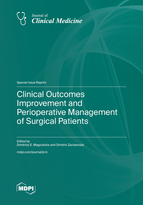Clinical Outcomes Improvement and Perioperative Management of Surgical Patients
A special issue of Journal of Clinical Medicine (ISSN 2077-0383). This special issue belongs to the section "General Surgery".
Deadline for manuscript submissions: closed (20 December 2023) | Viewed by 18222
Special Issue Editors
Interests: cardio-thoracic surgery; surgical oncology; bariatric surgery
Special Issues, Collections and Topics in MDPI journals
Interests: pancreatic surgery; liver surgery; bariatric surgery; surgical oncology
Special Issues, Collections and Topics in MDPI journals
Special Issue Information
Dear Colleagues,
The art and science of clinical outcomes analysis, quality improvement, perioperative management of surgical patients, and patient safety continue to evolve at an increasingly rapid pace. In fact, over the years, novel concepts have arisen (risk stratification, shared decision making, interdisciplinary meetings, prehabilitation, etc.), new initiatives have taken shape (e.g., state/nation-wide or international clinical databases), and new technologies and methods have been adopted across all surgical specialties (e.g., minimally invasive or robotic approaches).
In order to care for our patients, raise the standards of healthcare services, and be successful in today’s and tomorrow’s rapidly changing healthcare environment, understanding and evolving these topics represents an essential duty of all surgeons, physicians, and professionals related to surgical patients. In this context, we call all surgeons, physicians, and professionals from all the associated disciplines involved in the perioperative pathway of surgical patients (surgeons, anesthesiologists, radiologists, intensivists, cardiologists, oncologists, pulmonologists, nurses, physiotherapists, nutritionists, etc.) to contribute to this Special Issue. Our vision is to provide the best currently available evidence on this important topic, thus providing all the necessary information to clinicians on core concepts in the perioperative management of surgical patients.
Dr. Dimitrios E. Magouliotis
Prof. Dr. Dimitris Zacharoulis
Guest Editors
Manuscript Submission Information
Manuscripts should be submitted online at www.mdpi.com by registering and logging in to this website. Once you are registered, click here to go to the submission form. Manuscripts can be submitted until the deadline. All submissions that pass pre-check are peer-reviewed. Accepted papers will be published continuously in the journal (as soon as accepted) and will be listed together on the special issue website. Research articles, review articles as well as short communications are invited. For planned papers, a title and short abstract (about 100 words) can be sent to the Editorial Office for announcement on this website.
Submitted manuscripts should not have been published previously, nor be under consideration for publication elsewhere (except conference proceedings papers). All manuscripts are thoroughly refereed through a single-blind peer-review process. A guide for authors and other relevant information for submission of manuscripts is available on the Instructions for Authors page. Journal of Clinical Medicine is an international peer-reviewed open access semimonthly journal published by MDPI.
Please visit the Instructions for Authors page before submitting a manuscript. The Article Processing Charge (APC) for publication in this open access journal is 2600 CHF (Swiss Francs). Submitted papers should be well formatted and use good English. Authors may use MDPI's English editing service prior to publication or during author revisions.
Keywords
- clinical outcomes
- surgery
- quality
- quality of life
- quality improvement
- perioperative
- morbidity
- postoperative care








